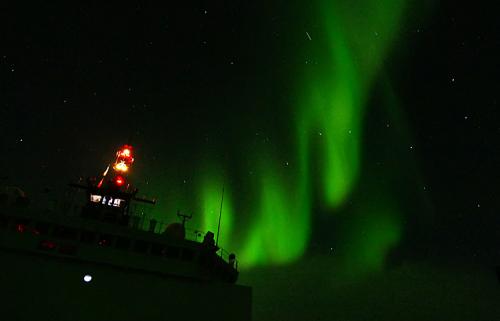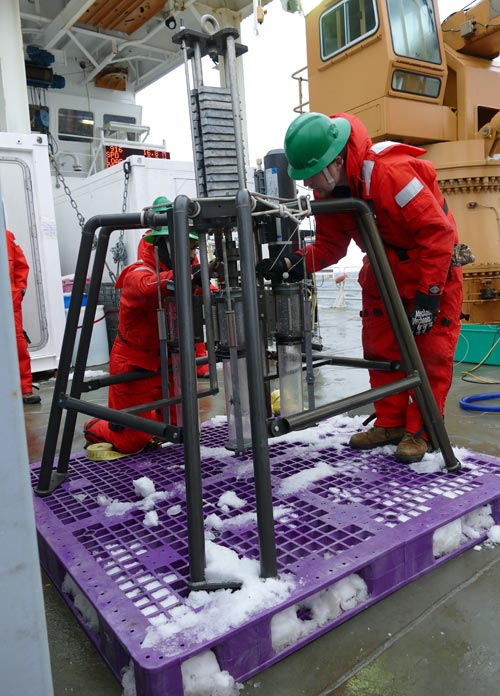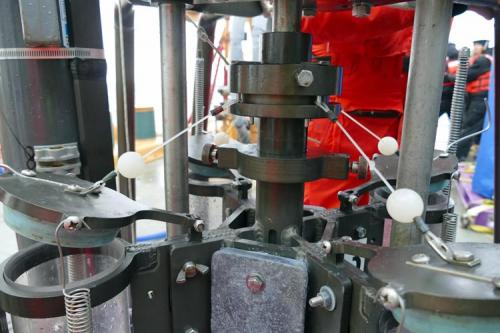Cruise Day 58
Speed 12 knots (kts)
Course 56° (NE)
Location Chukchi Slope, ~106 nm NW of Barrow, Alaska
Depth 264 m
GO DEEPER DISCUSSION: (see previous journal for the questions.)
Riddle Answer: The Wind
TODAY’S JOURNAL:
It has been a busy 24 hours, with a bit of a race against the wind finally over for now. We wrapped up a station last night and immediately pushed on to get one more chance at GEOTRACES sampling this today before the wind got too strong to operate. If the forecast holds up. winds and waves will grow through the night and stay strong tomorrow. In order to make the most of our dwindling expedition time we are backtracking a bit to do some repeat hydrography stations running down the Chukchi slope that were skipped in order to get in the last couple of GEOTRACES stations. Repeat hydrography can sample under stronger wind and wave conditions as they operate off the starboard A-frame which the ship shelters better than the aft A-frame that the GEOTRACES rosette uses. Our guideline is that winds over 20 knots shut down GEOTRACES sampling opportunities.
We also had a phenomenal auroral display again last night, with starry skies splashed green with sheets and ropes of plasma. One curtain in particular amazed us with successive bright vertical streaks sweeping rapidly along the length of the feature. While green has dominated the displays, the crew out working on a beryllium pumping cast around 2 am saw an eruption that included pink and purple fringes on the bottom of the brightest ribbons. In between bouts of aurora I enjoyed star watching with a northern perspective. Especially cool was picking out Polaris (the North Star) nearly overhead- by far the highest I’ve seen it in the sky.

We wrapped up today’s GEOTRACES station with a multicore sampling operation. We hadn’t used this gear since our trip north through the Chukchi Sea, but now that we’re back into shallow water the team decided to give it a try. The device has four sampling tubes and a Niskin bottle on a frame that looks a little like a lunar lander. As it is lowered onto the sea floor, a stack of lead weights pushes the sampling tubes into the sediment. When the weights push the sampling array far enough down a plate triggers release pins that allow stoppers on the tops of the tubes to snap shut and simultaneously close the Niskin bottle. Then, as the device is pulled up spring-loaded caps swing in underneath the tubes to complete the sample captures. Ideally, up to four sediment samples from the sea floor along with a water sample from right above the bottom can be retrieved.


You may have noticed the attention I’ve given to wind lately, and today it demonstrated why it can be such a hinderance. By the end of the station the wind strengthened to about 20 knots, with the Healy moving over the sea bed at up to 2 knots as the helmsman tried to keep the bow to the wind. The drift caused the multicore sampler to stream out behind the ship enough that it didn’t touch down vertically. Instead, the device dragged sideways on two legs without plunging the sampling tubes into the bottom or even triggering the closure mechanism. It was cool to see a clam and a worm from the bottom that came up on the sampler feet but a little disappointing to miss getting sediment samples. But it goes to show that when you are doing science it doesn’t always work the first time. If we get the chance I know we’ll try the multicore sampler again, but for now it is time to ride out the winds and waves again for a while.

GO DEEPER!
If you look closely at the aurora photograph in this journal, you’ll notice a short white line a little right of center near the top of the frame. This isn’t a flaw in the photo but something different than the stars. What is this object?
Aloft Con web cam updated every hour
Healy Track
That's all for now. Best- Bill


Comments